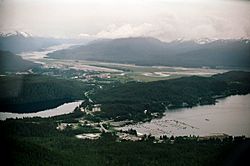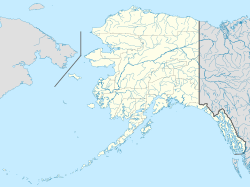Auke Bay, Juneau facts for kids
Quick facts for kids
Auke Bay
Áakʼw Tá
|
|
|---|---|
|
Neighborhood
|
|

An aerial view shows Auke Bay, including its harbor and Auke Lake.
|
|
| Country | United States |
| State | Alaska |
| Borough | City and Borough of Juneau |
| Elevation | 10 ft (3 m) |
| Time zone | UTC-9 (Alaska (AKST)) |
| • Summer (DST) | UTC-8 (AKDT) |
| ZIP code |
99801
|
| Area code | 907 |
| FIPS code | 02-04760 |
| GNIS feature ID | 1398469 |
Auke Bay (called Áakʼw Tá by the native Tlingit people) is a neighborhood in Juneau, Alaska. It is home to Auke Bay Harbor and Auke Lake. You can also find the University of Alaska Southeast here. The neighborhood has an elementary school, a church, a post office, and several shops and restaurants.
Auke Bay offers amazing views. The Mendenhall Glacier can be seen behind the bay. Mount McGinnis towers over Auke Lake. These spots are popular for taking photos. The Alaska Marine Highway ferry terminal is also located here. It is about 14 miles from Juneau.
A fun local sight is the flamingo house on Auke Lake. It is famous for its changing displays of pink lawn flamingos. These displays often match the weather or a special event.
You can also go Whale watching in Auke Bay. Many curious humpback whales visit this area. These whales are known for a special way of feeding called "bubble-net feeding". They work together to trap fish with bubbles. Sometimes, they come very close to the shore.
The Coast Guard cutter Liberty was based at Auke Bay Harbor for 33 years. This ship helped keep the waters safe. In 2022, it was moved to Valdez, Alaska.
Auke Bay gets its name from the native Auke people. They are a part of the larger Tlingit tribe.
Climate in Auke Bay
Auke Bay has a type of weather called a humid continental climate. This means it has warm summers and cold, snowy winters. There is rainfall throughout the year.
Auke Bay's History
Auke Bay first appeared in the U.S. Census in 1880. At that time, it was listed as three "Auk Villages." These villages were home to 640 Auke Tlingit people. The settlements were spread out, reaching Admiralty Island and Douglas Island. By 1890, the census grouped them as "Auk Settlements."
Later, it was simply called "Auke" in 1900 and 1910. Auke Bay did not appear separately again until 1950. By then, it had become a suburb of Juneau. In 1970, it was listed one last time before all areas within Juneau Borough became part of the city of Juneau.
The Alaska Clipper Stop
For several months in 1940, Auke Bay was a stop for the "Alaska Clipper." This was a large, four-engine flying boat. It was a Sikorsky S-42B aircraft. The plane was first called "Bermuda Clipper." It flew between Baltimore and Bermuda.
In 1940, it was renamed "Alaska Clipper." It then flew from Matthews Beach in Seattle to Auke Bay. It made a stop in Ketchikan along the way. The first flight landed in Auke Bay on June 14, 1940. The last flight was on November 6, 1940.
After its time in Alaska, the plane was renamed again. It became the "Hong Kong Clipper II." It then flew routes between Hong Kong and Manila. Sadly, the aircraft was destroyed. This happened during a Japanese bombing in Hong Kong Harbor on December 8, 1941.
Auke Bay Marine Station
For 47 years, Auke Bay was home to the Auke Bay Laboratories. This was a very important U.S. Government center. It studied fish that were important for fishing businesses in Alaska.
Scientists at the lab studied many types of fish. These included salmon, sablefish, and crabs. They looked at how many fish there were. They also studied how fishing and other activities affected the fish and their homes.
The first Auke Bay Marine Station opened in 1960. It was built with money from Congress. In 2016, the U.S. Government decided the 4-acre property was no longer needed. This was because the main lab had moved to a new building in 2007.
In 2017, a deal was made for the property. Part of it went to the University of Alaska Southeast. This helps their marine biology program. The other part went to the Juneau Docks and Harbors Division. This allows them to make the Statter Harbor facilities bigger.


